16 of Africa’s Most Incredible Hiking Destinations
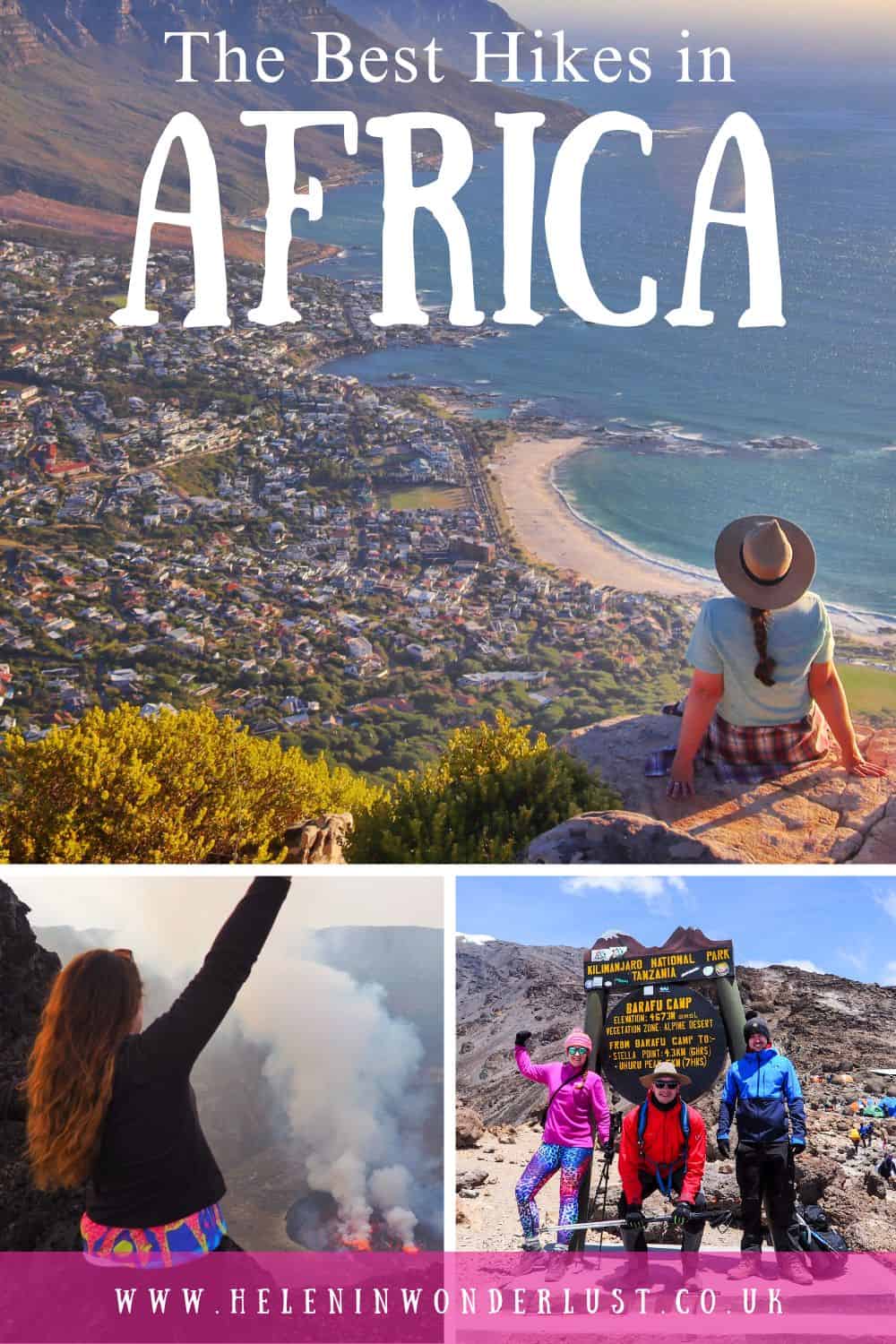
I love to be out in nature and there’s nothing better than hiking to really benefit from the great outdoors, and the African continent is full of beautiful and challenging hikes for the adventurous traveller.
Climbing Kilimanjaro was a dream come true for me and Mount Nyiragongo in the Congo was one of the most epic adventures I’ve ever undertaken, but there are so, so many more great treks on the continent.
I haven’t done them all (yet) so I asked some fabulous fellow travel bloggers to share their tips and experiences of hiking some of Africa’s best hiking trails!
Happy trekking!
Please Note: Some of the links in this post are affiliate links, which will earn me a small commission at no extra cost to you. Affiliate sales help with the running costs of this site, so thank you for your support!
The Best Hikes in Africa
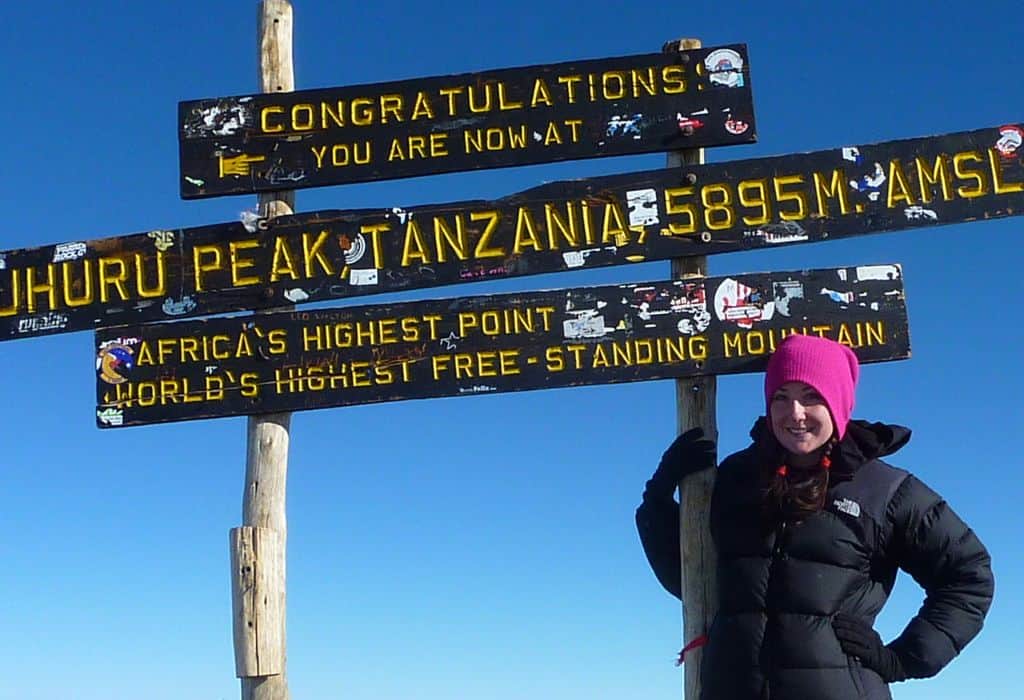
1. Mount Kilimanjaro, Tanzania
If there’s one African hike to rule them all, it’s Africa’s highest peak, the mighty Kilimanjaro, standing at an impressive 5,895m tall. This trek is one of my greatest achievements and still one of my favourite travel memories to date… I’ve climbed it twice now and both times were amazing!
The first time, I spent 6 days on the Machame Route, affectionately known as the ‘Whiskey Route’, a beautiful yet difficult trek and one of the most popular on the mountain. On my second trek, I climbed the Lemosho Route over 8 days.
On the trek you pass through different climate zones, the landscape varying dramatically from one day to the next.
The hike is tough and you need to have a good level of fitness and stamina, however, it is as mentally challenging as it is physical. But the biggest obstacle is the altitude, which makes the relatively steady trek more difficult at times, therefore it’s important to go pole pole, which means slow in the Swahili language (check out my Swahili language guide here).
You must hire a guide for your Kilimanjaro trek and I’d advise that you also have porters too. There are plenty of companies to choose from and you can book your trip on arrival, but just make sure that the company you choose has ethical practices and is part of the Kilimanjaro Porters Assistance Project.
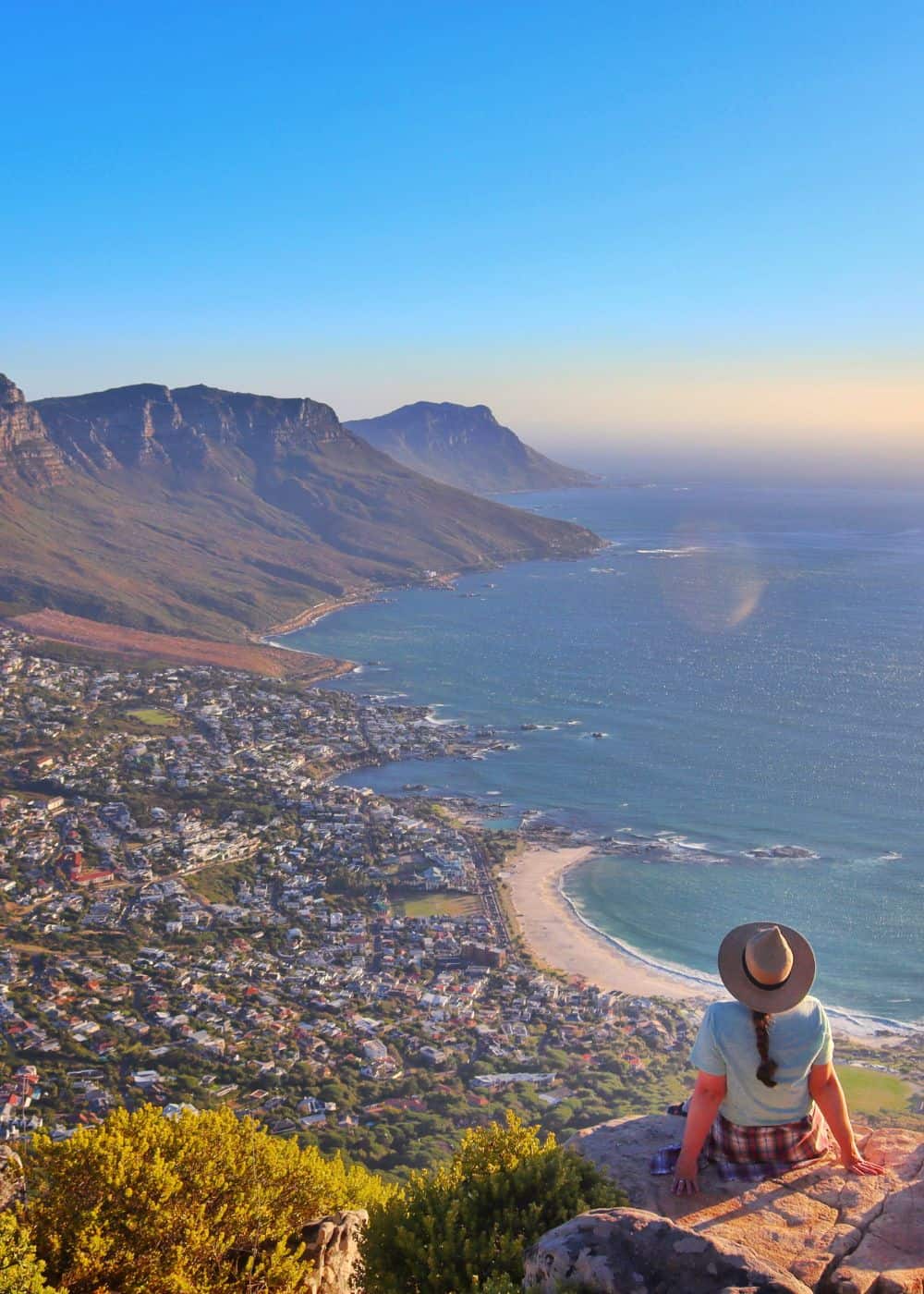
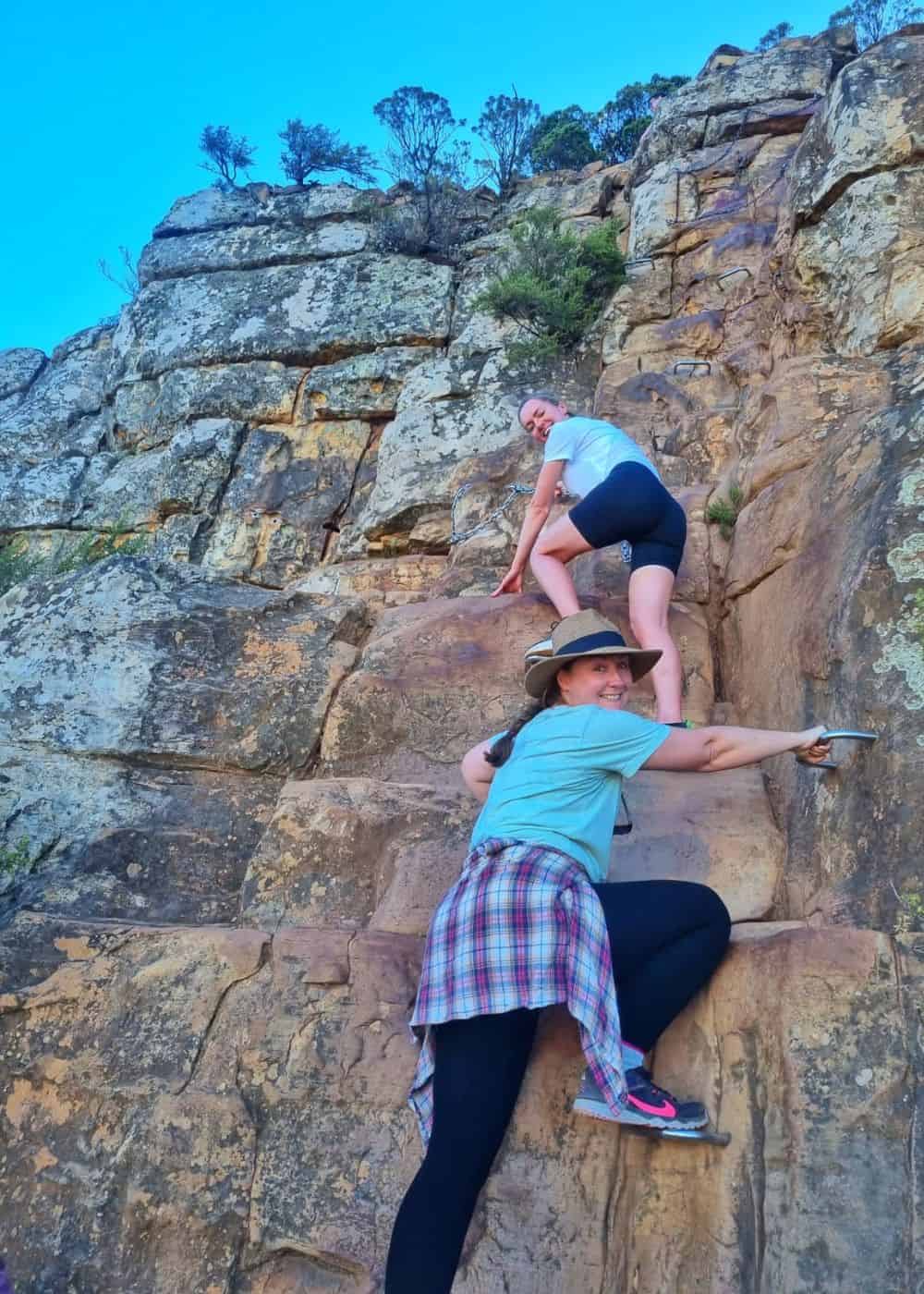
2. Lion’s Head, South Africa
One of my favourite things to do in South Africa is to climb Lion’s Head. It’s also one of the best free things to do in Cape Town too.
The hike starts from the Lion’s Head Car Park (on the way to Signal Hill). The first part of the walk is pretty easy, winding around the mountain at a relatively gentle gradient. But as you get nearer the top, it gets a little steeper and the route splits in two.
One goes around the mountain, and one goes straight up, using ladders and chain ropes. We tried to find the easier way, but couldn’t (and neither could the others climbing the same route as us), so up the ladders we went.
People often tell you to go up for sunrise or sunset, however, the hike is pretty precarious in parts (mostly the last part), so if you’re hiking with children, afraid of heights or not super confident climbing up ladders or scrambling, I would suggest going in daylight or with a guide.
You don’t need full hiking gear, but sturdy shoes, a hat, sunscreen and water are essential.
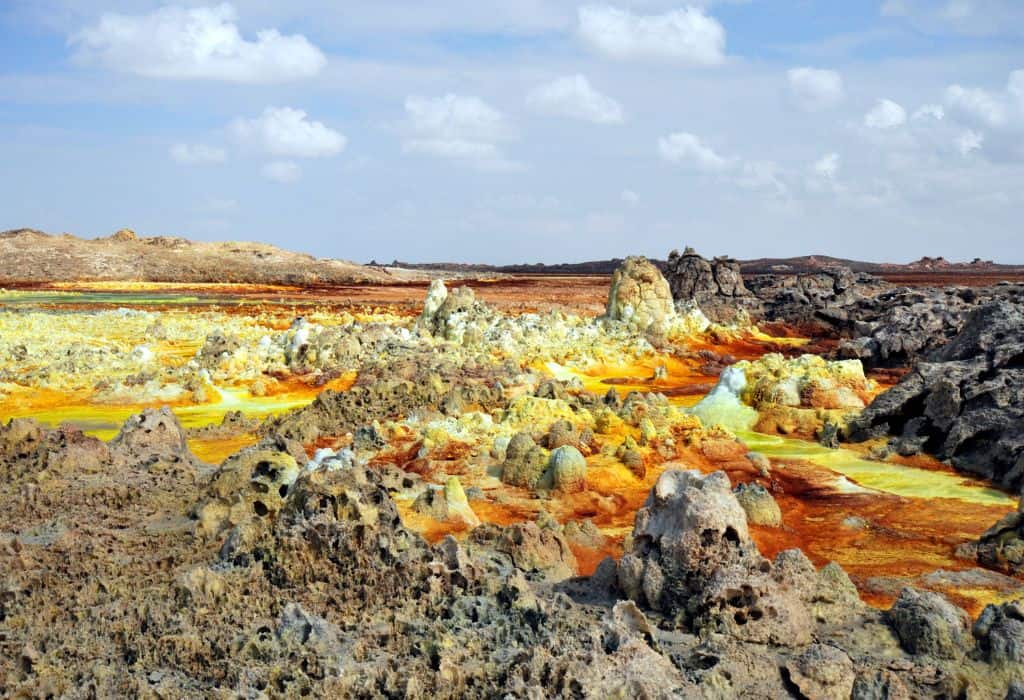
3. Danakil Depression, Ethiopia
Danakil Depression, a low desert between Ethiopia and Eritrea, is the home of the famous Erte Ale Volcano. This area is also home to the 6th lowest place and the hottest inhabited place on earth.
Due to border disputes, the only way to visit this place is by tour group with Afar guards armed with ancient AK-47s. Any Danakil Depression tour of 2-4 days based out of the city of Mekele will visit the Erte Ale volcano for trekking.
This volcano is the home to one of only six active lava lakes in the world and it’s an adventure just to get there – first driving a bumpy 1.5 hours over 12 km of dried lava to base camp. Most groups start the hike in the evening after dinner and after it’s completely dark as the hike can be completed in cooler temperatures. The hike to the outer rim involves 3 hours of hiking through loose sand, and then a steady uphill hill over dried lava to the rim. This is the place where you will camp.
Another 20 minutes hiking over fresh lava from a January 2017 eruption gets you to the view of the churning hot lava below. After viewing the crater at midnight, you get a few hours of sleep at the windy top before descending to base camp a couple hours after sunrise.
The trek is supported by guides and camels that carry extra water and bedding supplies. Rumour has it that the lava is not flowing as of early 2018 so check the conditions before booking to avoid disappointment.
Written by Lisa of the TheHotFlashPacker
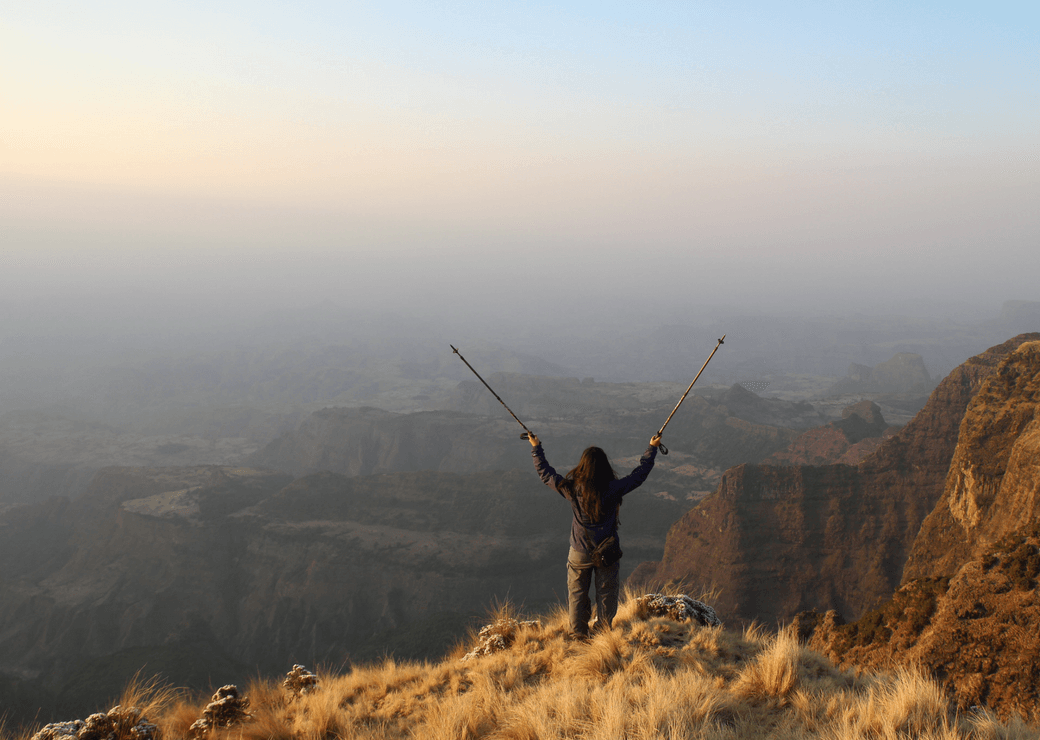
4. Simien National Park, Ethiopia
The spectacular ‘Simien National Park’ is one of the ultimate hiking destinations in Africa and a must-see for all those visiting Ethiopia.
While hiking in Simien, you pass beautiful jagged peaks, deep valleys, waterfalls and interesting wildlife such as mountain goats or Gelada monkeys. While many people visit Simien on a day trip from Gonder, the best way to enjoy the park is a multiple day trekking expedition which you can do independently or with a tour group.
Please note that you’re always required to bring along a scout, which is a way to offer local families some extra income.
A popular route is the 3 or 4-day hike to Geech or Cheneck camp. This route takes you past Imet Gogo viewpoint with an unforgettable 360 degrees view. It’s an easy-moderate difficult hike, but people may experience signs of altitude sickness as you quickly reach 3000+ meters. It’s possible to sleep in your own tent or (at some places) in a wooden cabin.
I absolutely loved my time in Simien. The views are absolutely breathtaking, the Gelada monkey’s fascinating and the camp dinners were cosy and fun!
Written By Manouk from Bunch of Backpackers
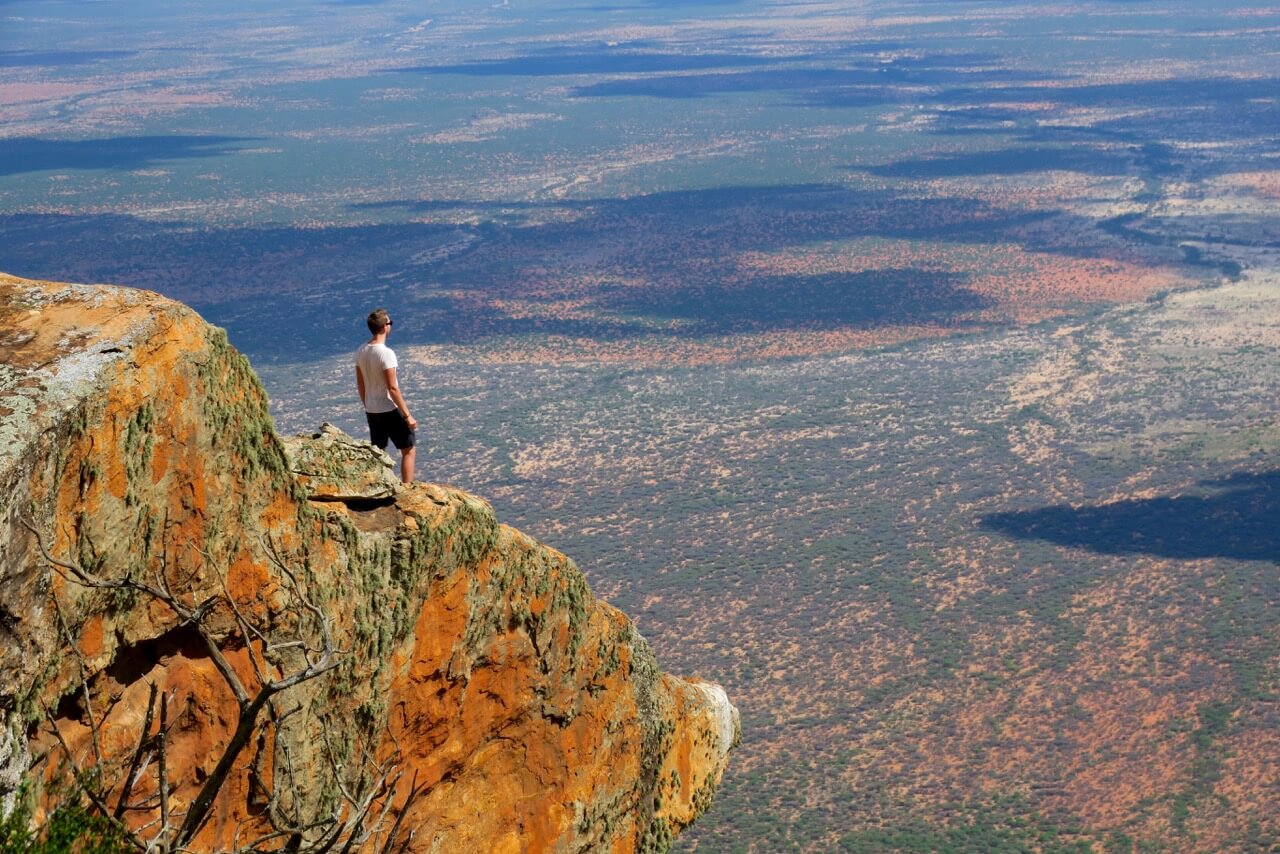
5. Mount Olokwe, Kenya
My favorite hike in Africa is at Mt. Ololokwe in Kenya, one of the highlights of Northern Kenya. This holy mountain is located in Samburu country, a wild and rather non-touristic region of Kenya, north of the main cities and attractions of the country. We had to be accompanied by two armed local guards to protect us from wild elephants and hostile tribes during our hiking adventure.
The climb up Mt. Ololokwe is quite steep, but absolutely worth it. After reaching the mountain plateau, we had incredible views of the vast and wild African landscape. The second part of the hike on the plateau is rather easy, since thereâ’s no big altitude change anymore. We went to some viewing points and climbed back down on the same day to sleep in a lodge on the foot of the mountain.
However, apparently, this lodge got closed and most people camp one night on the top of Ololokwe before returning back. The hike is rather non-touristic (we got told we were the first visitors in 3 months!), but one of my big highlights in Africa!
Written By Patrick of The German Backpacker
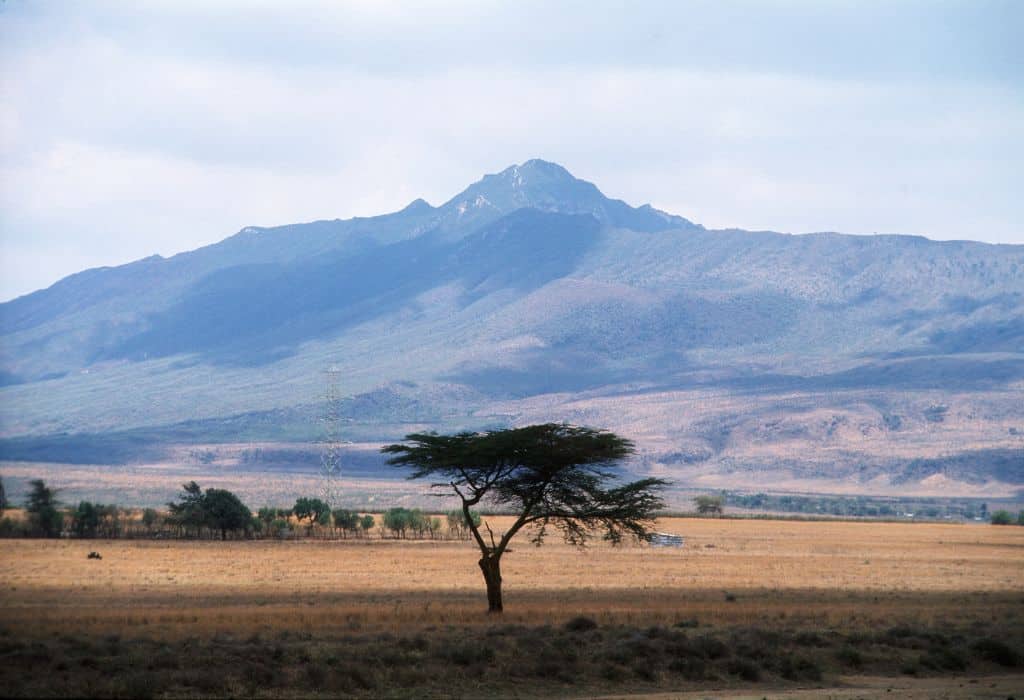
6. Mount Longonot, Kenya
This volcano in the middle of the famous Great Rift Valley makes for an excellent day hike from the nearby city of Nairobi. You’ll need to rent a car, hire a driver, or take a tour to get here, but the trouble will be well worth it, as will the moderately grueling hike.
The hike starts at the base of the volcano, and the first stretch takes you through open savanna. Keep your eyes out, because it’s not uncommon to run across zebras, giraffes, and wildebeest along the way. The trek then takes you up the side of the volcano, with a steep but not too technical hour-long climb that will reward you with a incredible vista as you reach the crater rim.
From the rim, you’ll be able to look down into the crater and witness the majesty of the small isolated forest ecosystem growing within the dormant volcano. Or look outward and you’ll see what seems like half of the Kenyan plains stretching out before your eyes. If you’re only interested in a moderate hike, you could turn back here, but for a true adventure, follow the trail that circles the rim (with the mountain summit halfway around).
The best thing about hiking Mount Longonot? It’s not an overtouristed site, you may well have the entire volcano to yourself!
Written By Nate from Travel Lemming
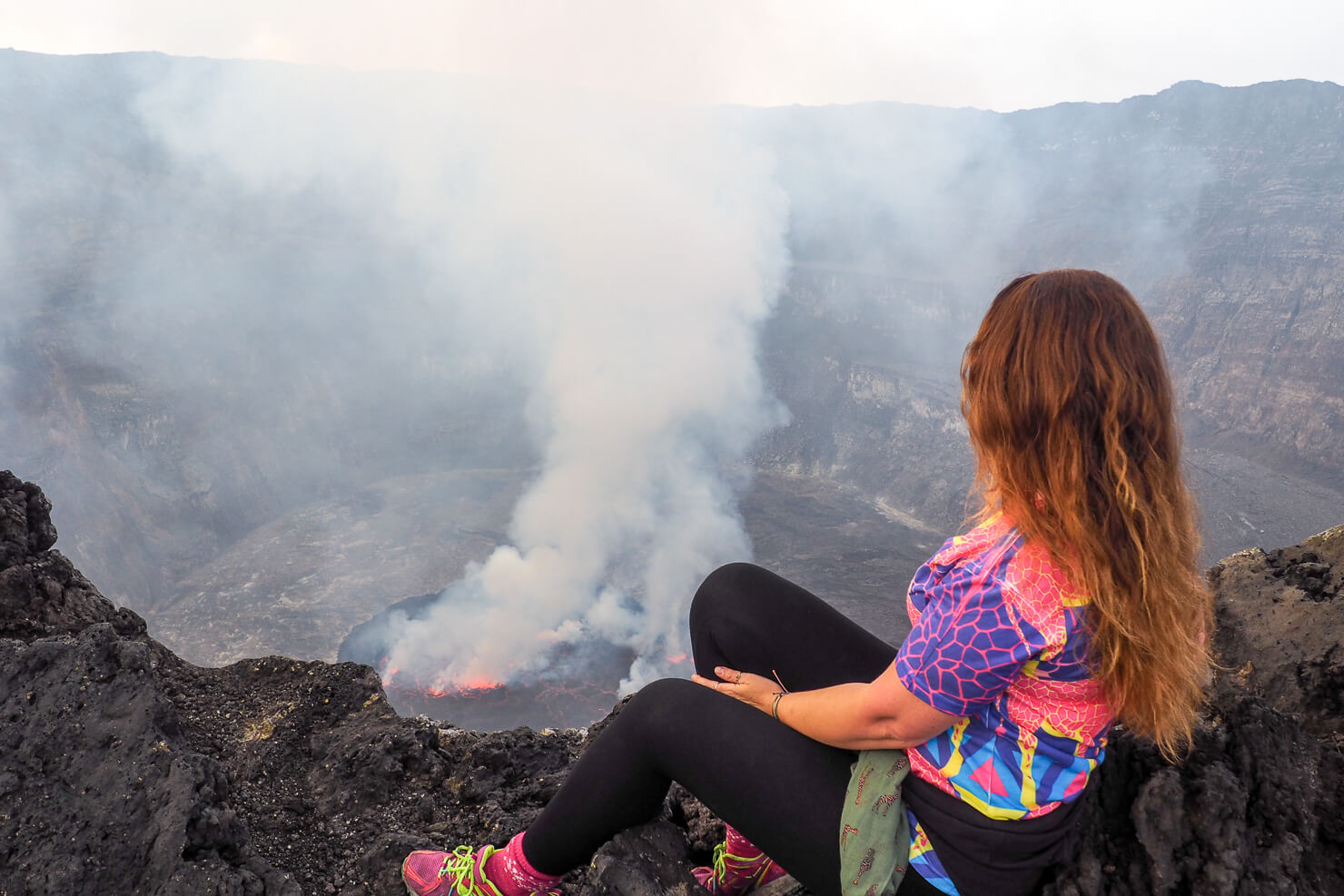
7. Mount Nyiragongo, Democratic Republic of the Congo
One of the most incredible moments of my life was standing on the crater rim of Mount Nyiragongo volcano in the Democratic Republic of the Congo staring into one of the world’s rare lava lakes.
Starting in the city of Goma, or at one of the . You will be picked up by your armed rangers who will take you to the start point of the trek where you will sign in and meet your porters.
It takes around 6 hours of steep, uphill trekking to reach the top and the loose lava underfoot provides an extra challenge. In 2002 the volcano erupted sending lava flowing down the mountain and creating the incredible landscape you see today.
At the top, you will be wowed by the view, however the real exciting part comes in the evening, when the lava glows bright red against the black of night. You stay in basic huts at the top, so you can gaze at the lava all night if you wish… however it’s freezing up there so most people spend an hour or two max!
To read more, check out my guide to climbing Mount Nyiragongo in the DRC.
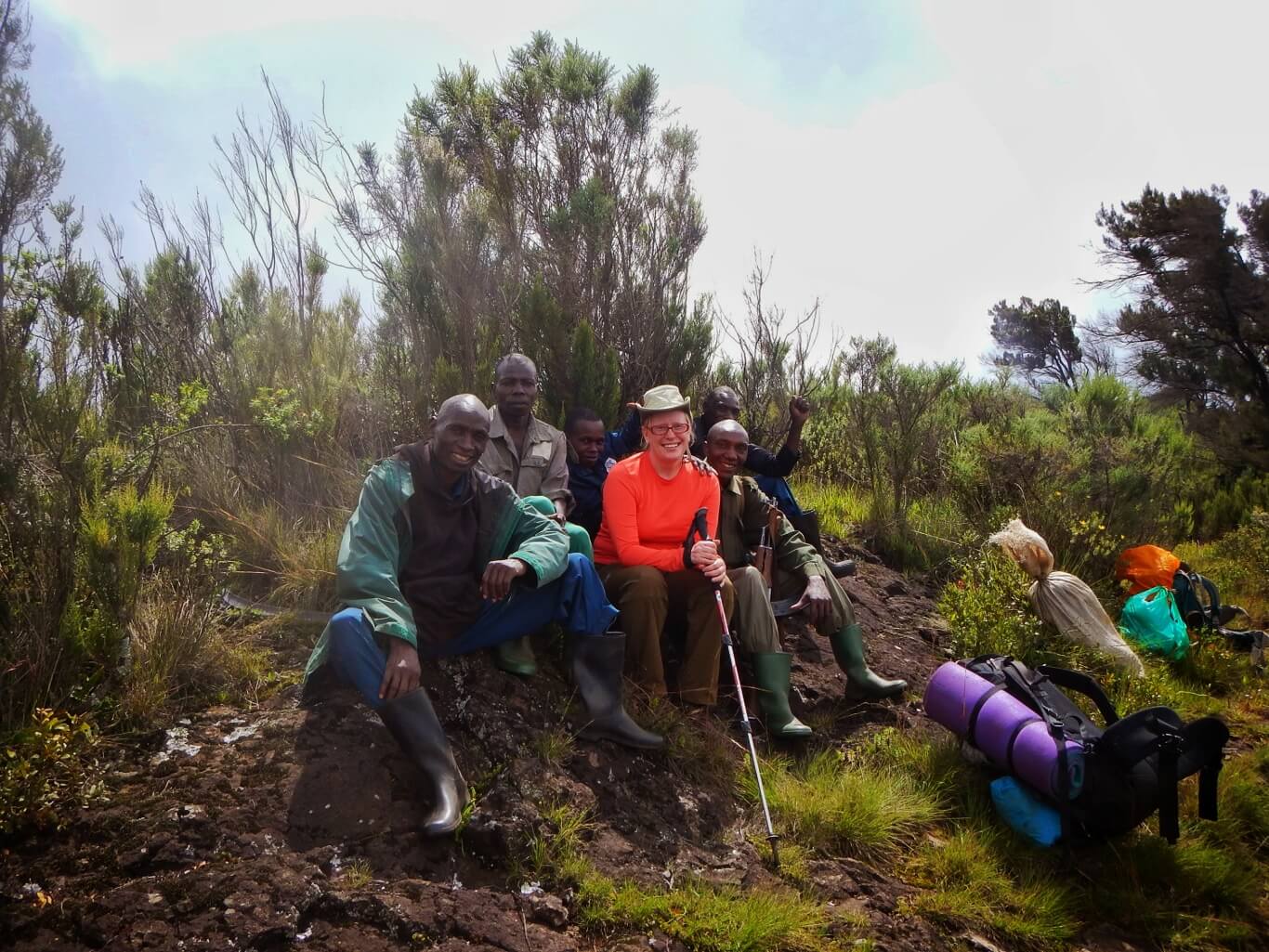
8. Mount Elgon, Uganda
Mount Elgon is one of the best things to do in Uganda.
Rising to 4321 meters or 14176 feet, Mount Elgon has the longest base of any mountain in the world and the second-largest caldera. It also features incredible bio-diversity and exhilarating views into neighbouring Kenya from the summit on Wagagai peak.
There are a few routes to the top, with the most common route taking only 3 days. We chose to take the 4 day Sasa to Sipi Route so that we would finish our trek in the picturesque village of Sipi Falls. We arranged our trek at the Uganda Wildlife Authority office in Mbale, and then spent the night in a small town near the trailhead called Budadiri where our guide Moses met us. He brought a couple of porters to carry our camping supplies, as well as a cook with him.
Despite me being very sick before the trek, our team reached the summit on the second day citing Uganda Power!’ as the source of our success. On the third day, we traversed multiple rolling peaks and valleys before camping for the night, and on the last day we found ourselves in beautiful Sipi Falls.
There we gazed in awe at the gorgeous 3-tiered waterfall, sipped on delicious local coffee, and wondered at just how far Uganda Power can take you.
Written By Thea of Zen Travellers
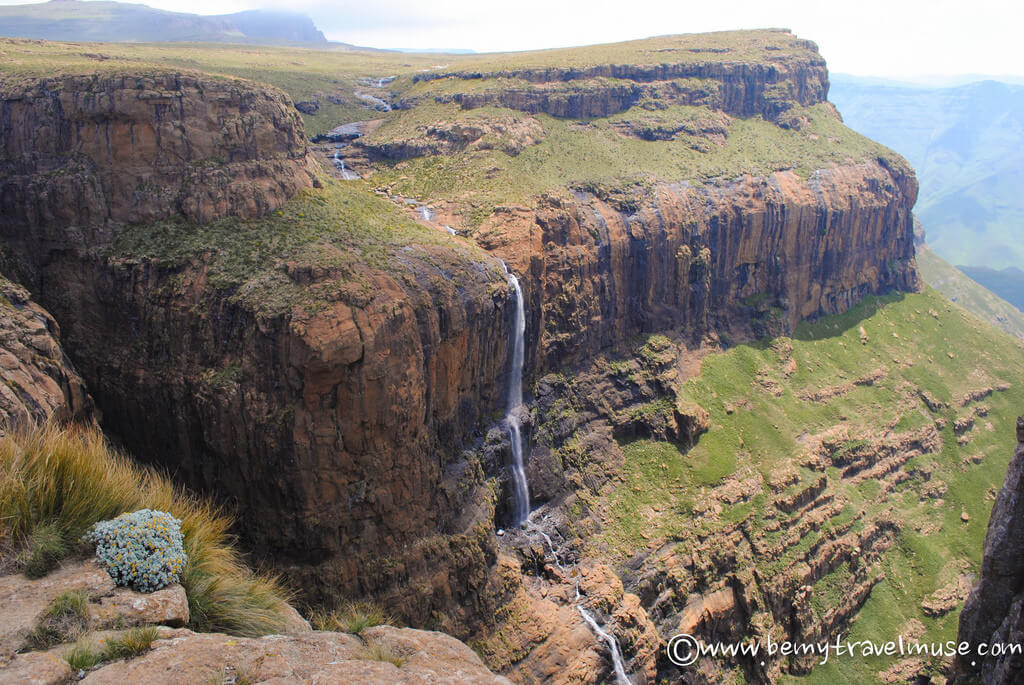
9. Sentinel Peak Hike, South Africa
The Sentinel Peak hike in the Drakensberg in South Africa provides sweeping, impressive views not just of the canyons and plateaus nearby, but of the incredible Tugela Falls. It’s not a particularly long hike, originating in the Sentinel car park and meandering on a mostly flat trail for four hours or so, round trip.
The biggest challenge, especially for those who don’t like heights, is the chain-link ladder to the top. It’s worth the effort, though, because the waterfall view across the way is absolutely stunning! From there, you’re high up on a plateau that shares a border with Lesotho. You may even come across some horsemen, which we did. They were jokesters!
If you have the time, walking along the plateau offers incredible views as well. The Drakensberg in general is incredibly green, with dramatic rock formations and valleys. This hike gives you a nice panorama. If you only have time for one hike in the area, make it this one!
Written By Kristin of Be My Travel Muse
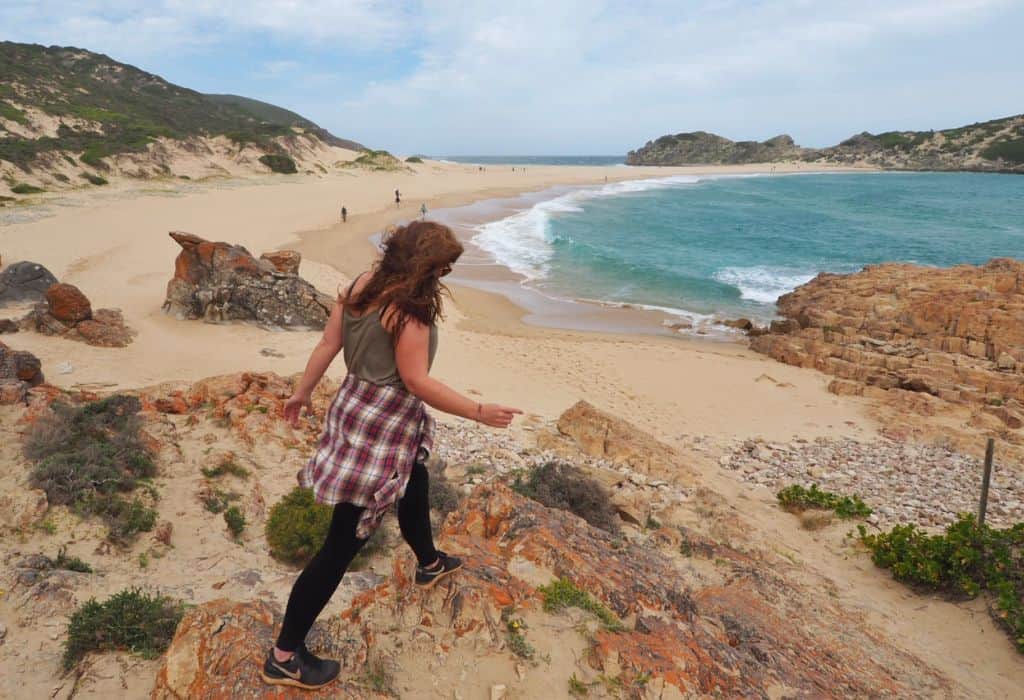
10. Robberg Peninsula, South Africa
If you are looking for a coastal hike with ever-changing scenery in South Africa then look no further than the Robberg Peninsula. Located near Plettenburg Bay, on the Garden Route in South Africa, this hike has it all and should definitely be added to your South Africa itinerary.
There is a choice of three walks – short, medium, and long, all can be followed independently. We choose the medium length hike, which was approximately 6 kilometres in length. This hike had us climbing up and down the rocky coastline, took us past an enormous seal colony, and had us climbing and running down a massive sand dune at the centre of the peninsula onto a beautiful beach. The hike took us about three hours with a stop for a picnic lunch and lots of photographs.
The longer hike was just over 9 kilometres in length and would take between 4-5 hours.
This is a spectacular hike, with constantly changing scenery and plenty of interest with rock scrambling, dune walking and beautiful beaches. For anyone planning on visiting the Garden Route in South Africa, put this hike at the top of your list.
Written By Nicky of Go Live Young
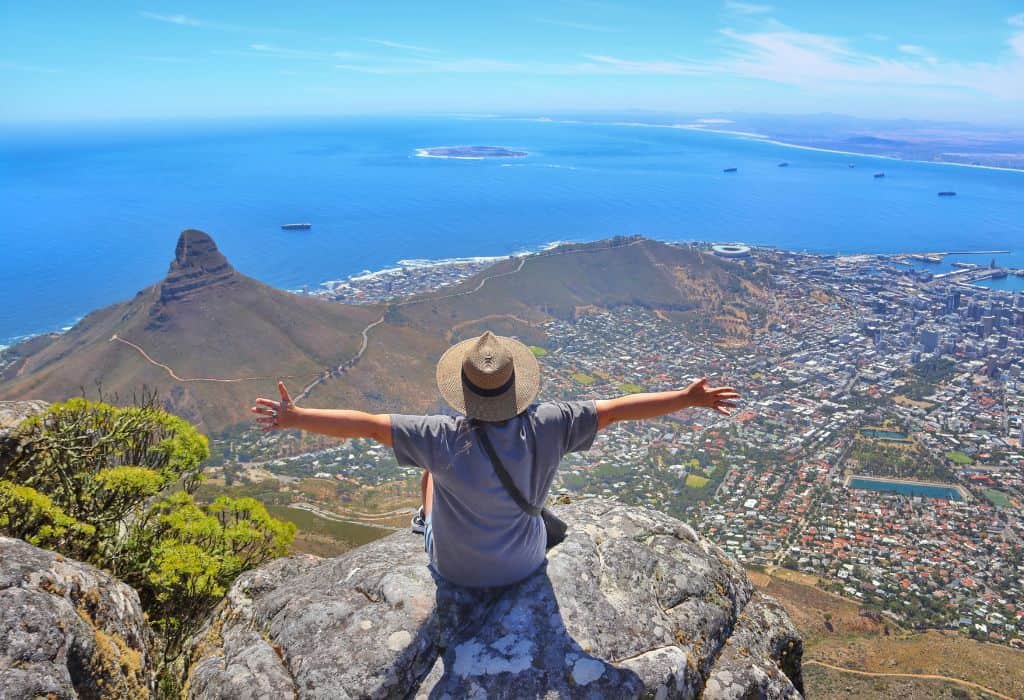
11. Table Mountain, South Africa
Table Mountain is a prominent flat-top mountain that provides amazing views of Cape Town and the surrounding area.
Although there are a number of ways to scale Table Mountain, including aerial cableway, a hike up Skeleton’s Gorge to the summit is a visually stimulating and diverse way to explore the environment. The hike up Skeleton’s Gorge begins with a short walk through the Kirstenbosch National Botanical Gardens to the trailhead.
Although initially flat, the trail quickly turns into a steep uphill walk, including numerous vertical climbing ladders and a rock wall (the Skeleton’s Gorge). It had rained just before our hike, so the rock wall was obscured almost entirely by water falling down the slippery rock face.
I was thrilled that we had the foresight to hire a guide as there is no way I would have considered climbing the rock wall without the expertise of someone who had done it multiple times.
After reaching the top, we walked across the plateau before taking the cable car back down to the base of the mountain. The entire round trip took approximately 5 hours and can easily be done in one day. In adverse weather conditions, the cable car can and will shut down, so we were prepared for a steep walk back, which thankfully was not necessary.
Written By Nancy of We Go With Kids
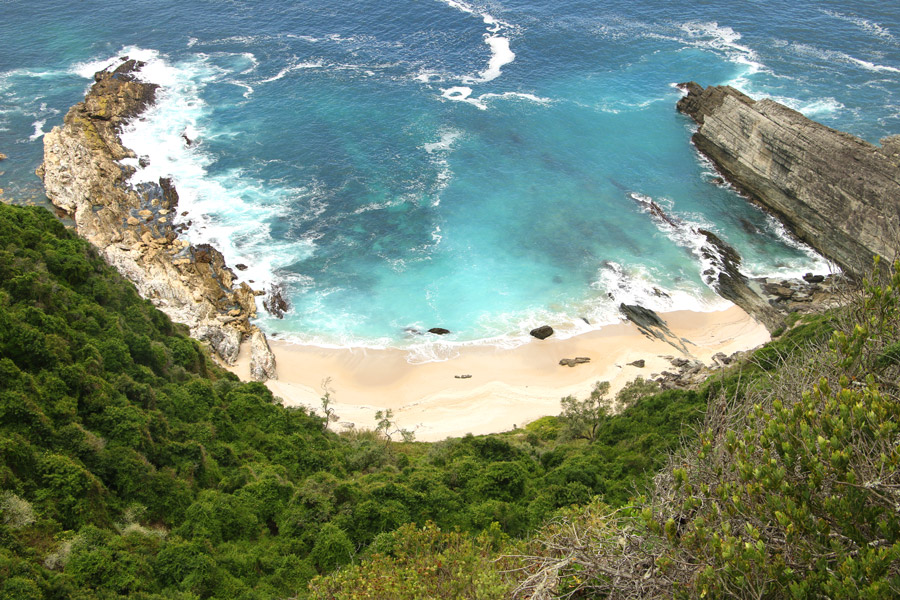
12. Otter Trail, South Africa
The Otter Trail on South Africa’s Garden Route is probably the most famous hike in the country and is often mentioned as one of the most beautiful hikes in the world. The stunning trail boasts breathtaking scenery meandering along the coast; passing white-sandy beaches, rocky cliffs, indigenous forest and awesome waterfalls.
With a bit of luck, some patience and a good eye you can see plenty of wildlife while hiking the Otter trail. Keep a look out for whales and dolphins in the sea; otters and seals at the rocks; genets, deer, monkeys and many birds in the forest.
The Otter Trail is an unguided 5-day hike with a total distance of 45km. The days are relatively short, but there are some steep climbs and a moderate level of fitness is required. Hikers stay in overnight huts with good facilities. Food, stove and cooking utensils must be brought for the duration of the hike, so pack light! All the huts have beautiful locations by the sea with incredible views.
The main challenge of the trail is the Bloukrans river crossing on the 4th day. Plan your day to cross the river at low tide with the water not higher than waist deep, take a dry-bag or survival bag along to pack your backpack in for the crossing.
The hike can be done all year round and is very popular. There are 12 daily spots available, to book for a group you have to do so months (sometimes a year) in advance, but small groups often get lucky with cancellations.
Written By Campbell & Alya of Stingy Nomads
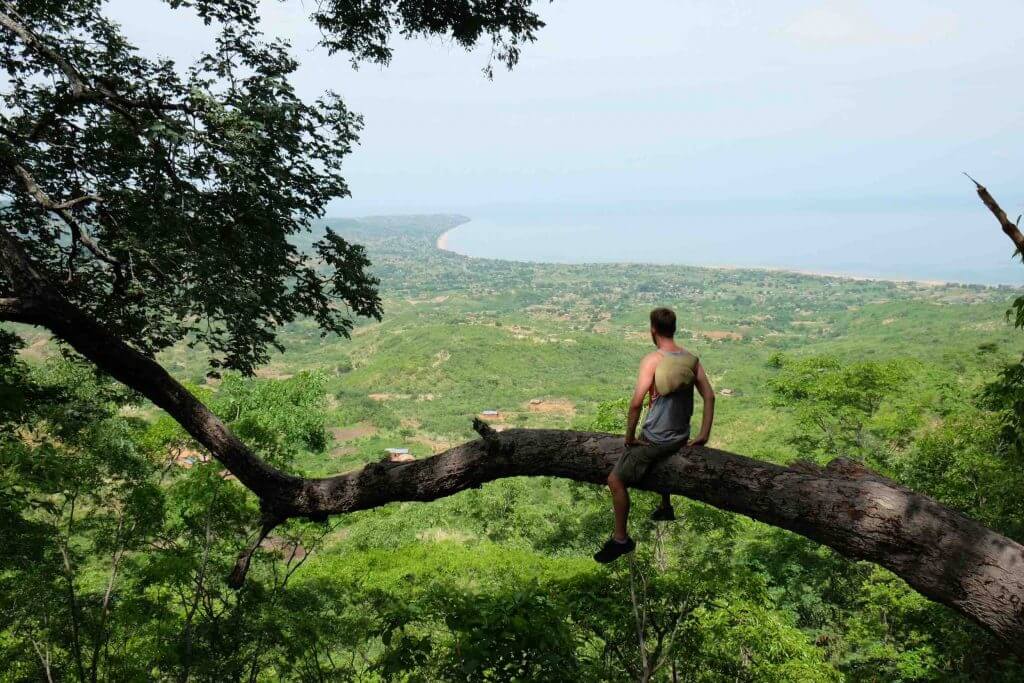
13. Livingstonia, Malawi
In the mountains of Northern Malawi is a small town called Livingstonia, a must-visit on any Malawi itinerary.
It was originally established in the late 1800’s by missionaries looking to escape malaria around the lake, and went higher.
Livingstonia is 900 meters above the lake and is accessible by either driving up hairpin African dirt roads or hiking from Khondowe. Although we had a truck, we decided to get active and do the hike up.
We are reasonably fit and the hike up took us a little less than three hours. We met plenty of locals that do the hike in less than an hour every day with the knowledge of shortcuts. Unfortunately, we didn’t know where those shortcuts were. It’s also possible to hitch a ride with a few of the local trucks for a few thousand Malawian Kwacha.
I personally loved the hike and the views we were given over Lake Malawi. However, I would recommend bringing enough water to last you under the hot African sun and don’t underestimate sunscreen. There are a few natural springs near the top to refill.
The hike is best done in the morning before the heat of the day sets in. The hike is mildly difficult with steep points, but any person with mild physical ability should be able to complete it without a problem.
Once you reach the top you are rewarding with amazing views over Lake Malawi. As well as Manchewe Falls nearby, and a coffee shop, local shops, and the beautiful Livingstonia Mission Church in town. I would recommend staying at Lukwe Eco Camp for at least one night for a good nights sleep. Don’t forget to try dinner there for fresh and local product. (Bring cash, many places won’t accept credit card).
Written By Natasha & Cameron of The World Pursuit
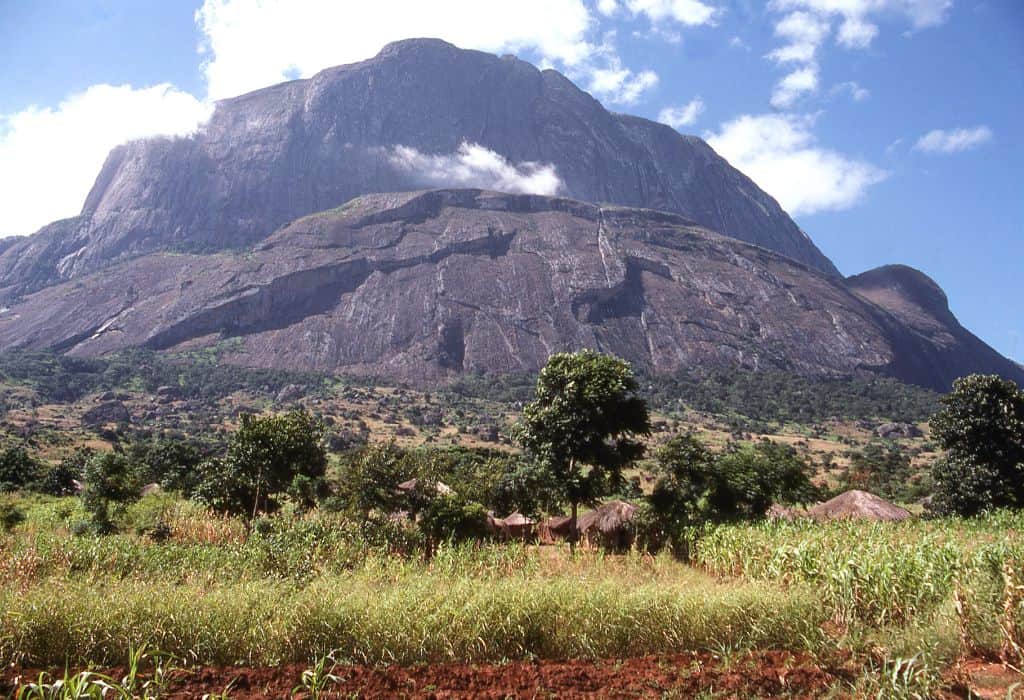
14. Mount Mulanje, Malawi
From the fields of tea plantations around the bottom to the rocky peaks at the top, Mount Mulanje is a beautiful place for trekking and one of the major highlights of Malawi.
There are a number of different trails around the mountain that can be explored in anything from 1 to 6 days. The most popular hike, however, is the 3 to 4 day trek to Sapitwa Peak. At 3002m this is the highest peak in Central Africa. On a clear day, the views are spectacular!
The best time to go is early in the dry season between April to August. As with most African Mountains maps aren’t available, so the only way to avoid getting lost is to take a guide. They are cheap and easy to arrange from the Forestry Office in Likhubula.
Alongside the spectacular scenery, one of our favourite things about Mulanje was the Mountain Huts. There are 10 different huts at various points on the mountain which provide overnight shelter for hikers. The huts themselves are basic, but they’re cosy and a great way to meet other hikers. Each hut is staffed by a watchman who will make you a fire, provide you with hot water for washing and cook you a hearty dinner. Exactly what you need after a long day trekking!
Written By Kingsley & Nicola of Kic Travels
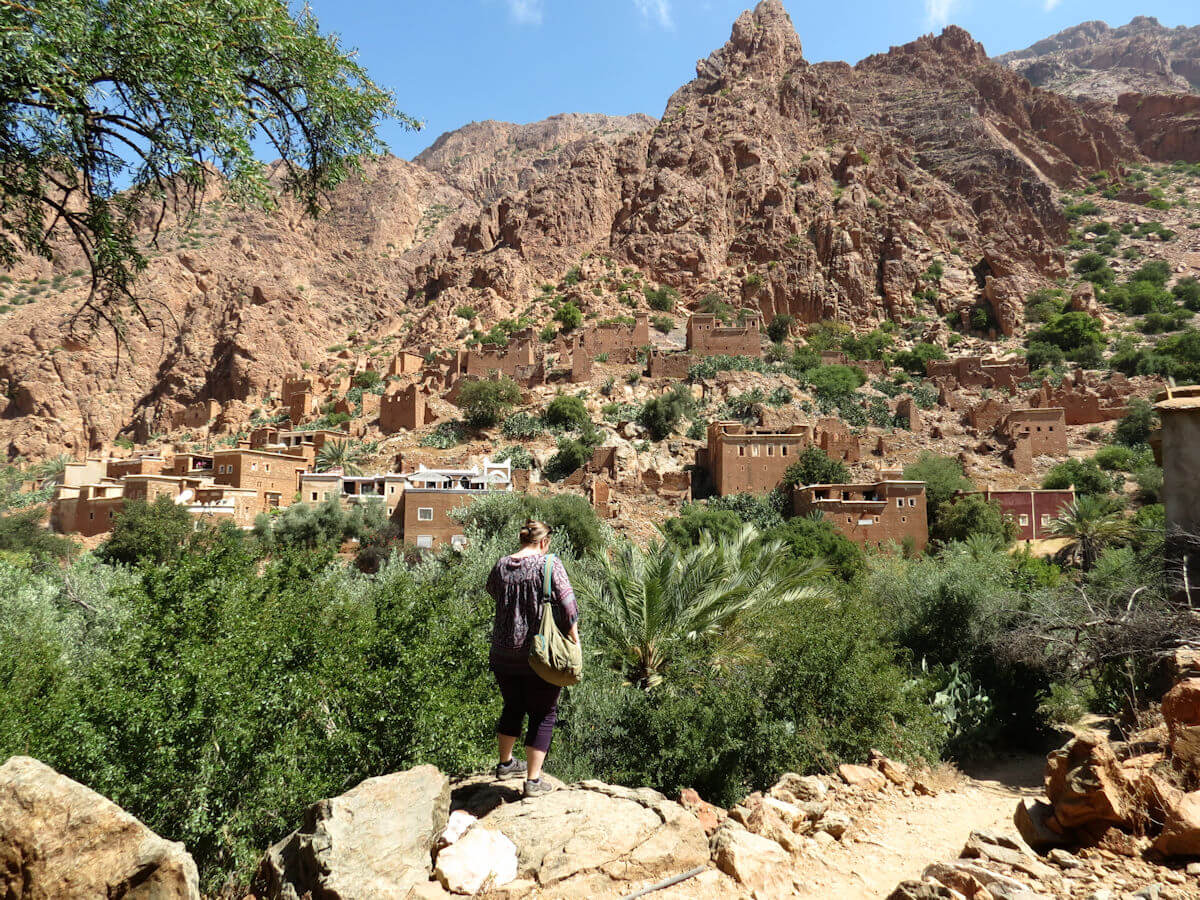
15. Ameln Valley, Morocco
We love hiking in Morocco, both for the dramatic landscapes and for the people we met along the way.
One of our favourite year-round trails is in the beautiful Ameln Valley, hidden away in the heart of the remote Anti-Atlas Mountains. This may be only a half-day hike and a fairly easy one at that, but where else can you encounter wild boar, snakes, and even lions whilst also being invited into the homes of locals for mint tea and a chat about football?
The trail begins just outside the village of Tafraoute and follows the valley past the famous lion-shaped cliff face, winding through sleepy hamlets before looping back along the foot of the towering red mountains. We went independently, taking a ‘photo map’ from our guest house Chez Amaliya to help us navigate.
About half way into the walk at the village of Oumesnat there’s a delightful old Berber house which has been preserved as a museum. It’s a great place to stop for some shade and a refreshing glass of mint tea. We loved chatting with our host Mustafa about his silver teapot collection, the meaning behind different coloured Berber shoes, and of course, our local Manchester United football team.
Everywhere we go this is a favourite topic of conversation! Heading back on the rocky trail past adobe mud houses and hundreds of palm trees we finally made it back to the start and promptly treated ourselves to a dip in the pool. If you ever try this hike, make sure you take plenty of water and a sun hat!
Written By Heather & Pete of Conversant Traveller
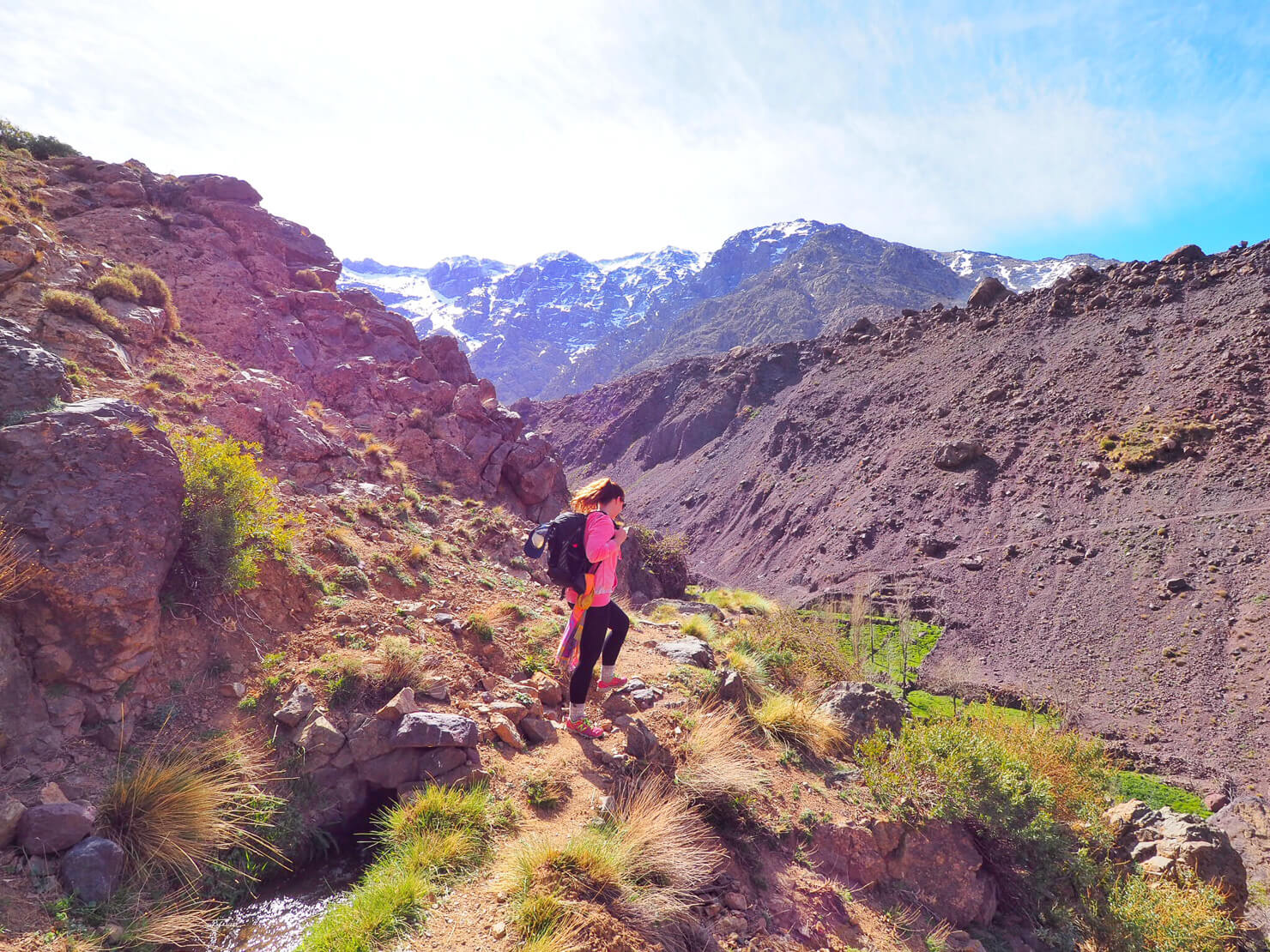
16. Mount Toubkal & the Atlas Mountains, Morocco
Take at least a week to savor your surrounding in the Atlas Mountains of Morocco, a far cry from the madness of Marrakech.
Specifically, Mount Toubkal is a spectacular climb to the top – at 13,000 feet. You can snake your way through neighbouring villages to reach modest accommodations, before doing the bulk of the climb in about a day from Mount Toubkal base camp.
It’s strenuous but doable by most climbers who had some experience, as long as the weather cooperates. You’ll want a guide or tour to complete this trek, which often starts from the city of Marrakech.
If you want something a little tamer, you can make a goal of simply reaching the Kasbah du Toubkal. It’s reachable by jeep, then a small trek to the property. They also have a few day and overnight hikes that start from the kasbah and are easier than a full trek. You can indulge in their hammam treatment rooms, amazing tagine cuisine, and mountainside yoga classes to celebrate the climb.
Written By Eileen from Pure Wander
Do you have any other great African hikes to add to the list? let me know in the comments below!
Pin This Post For Later
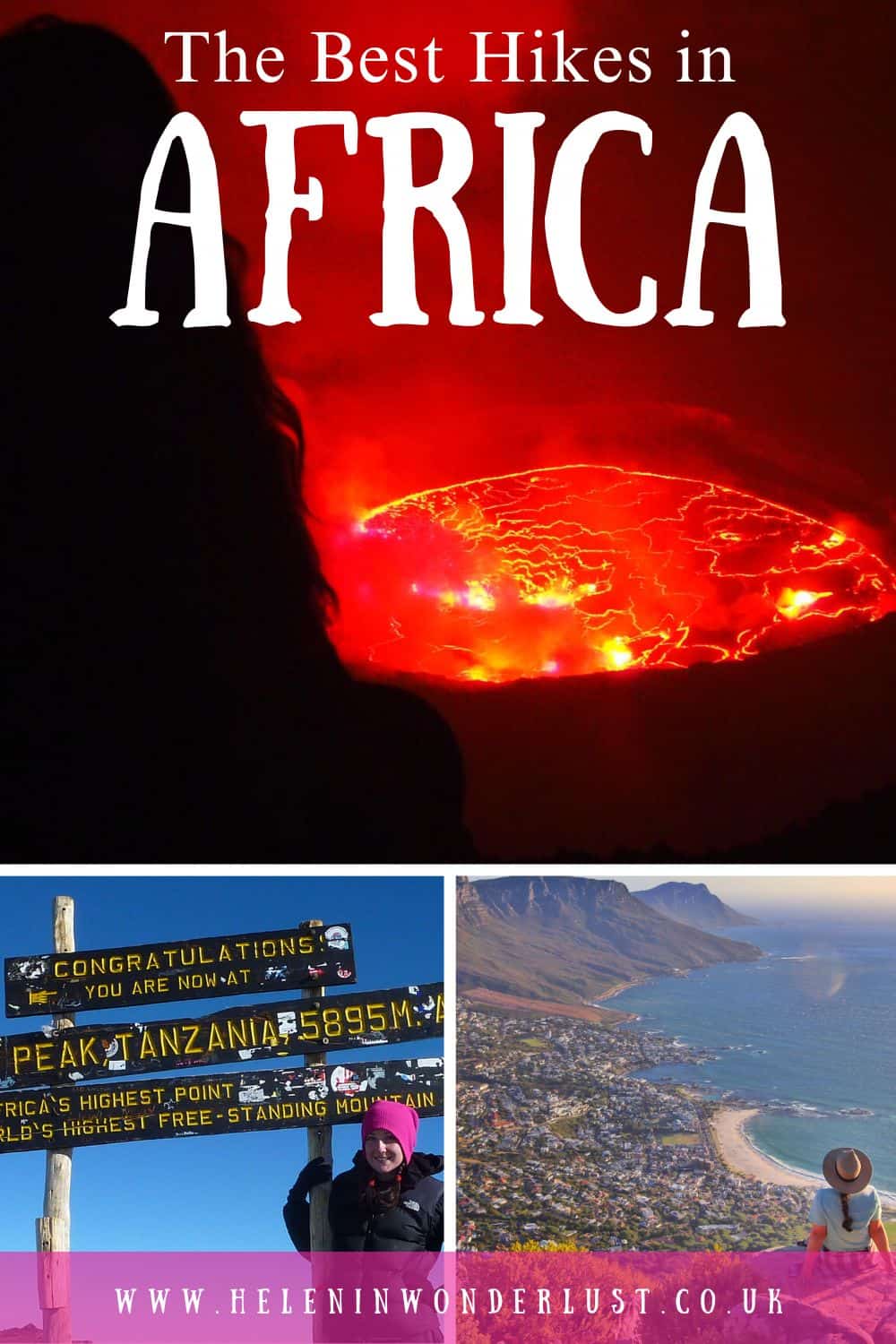


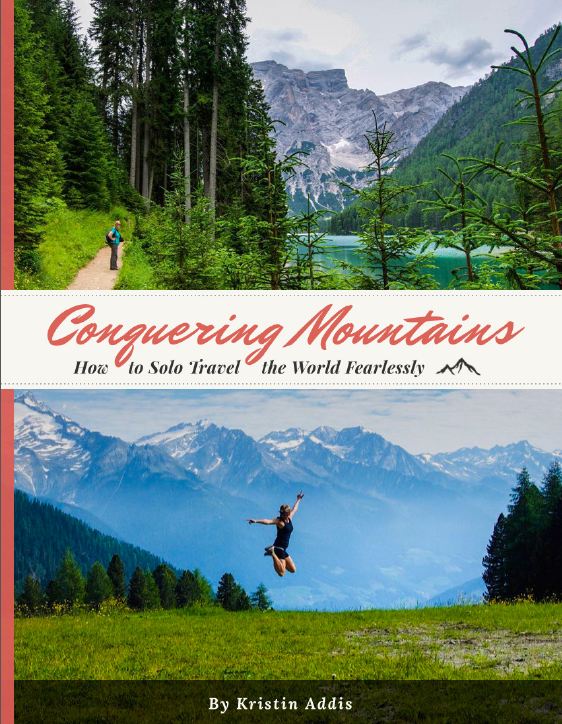
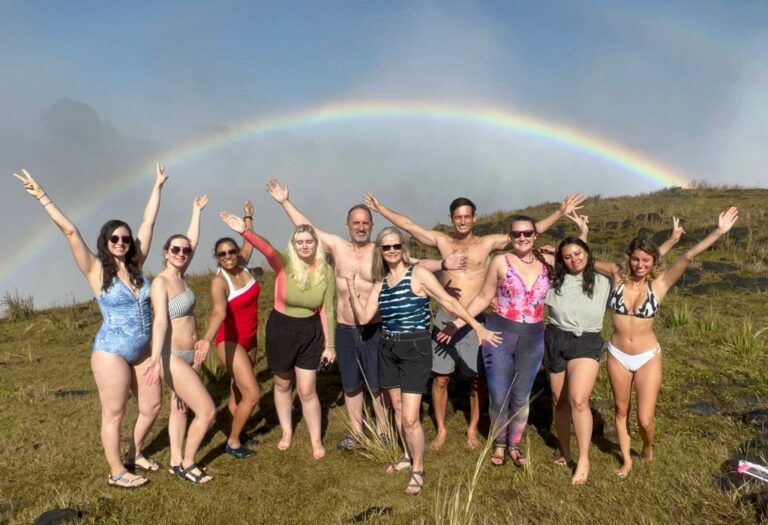
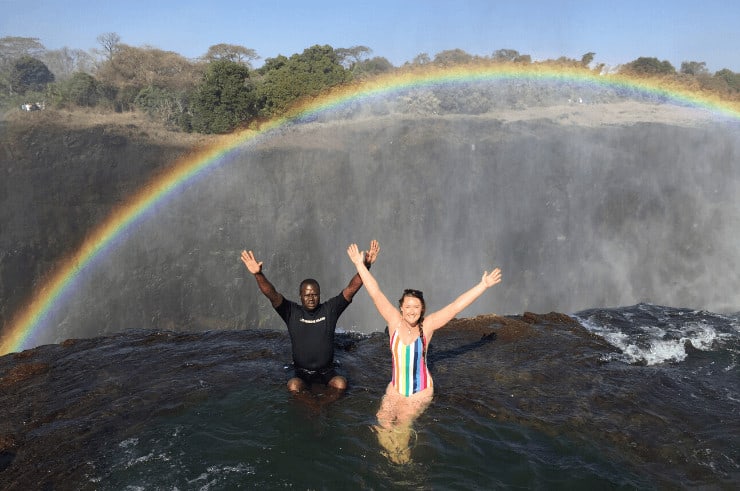
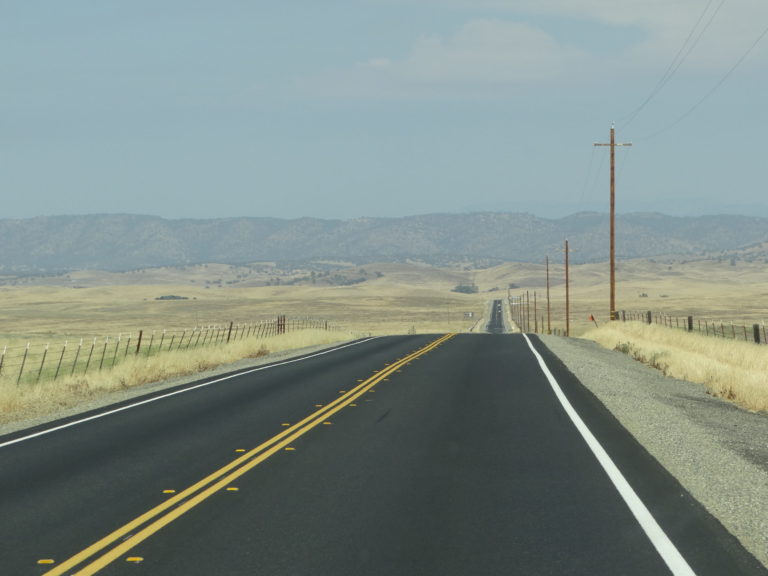
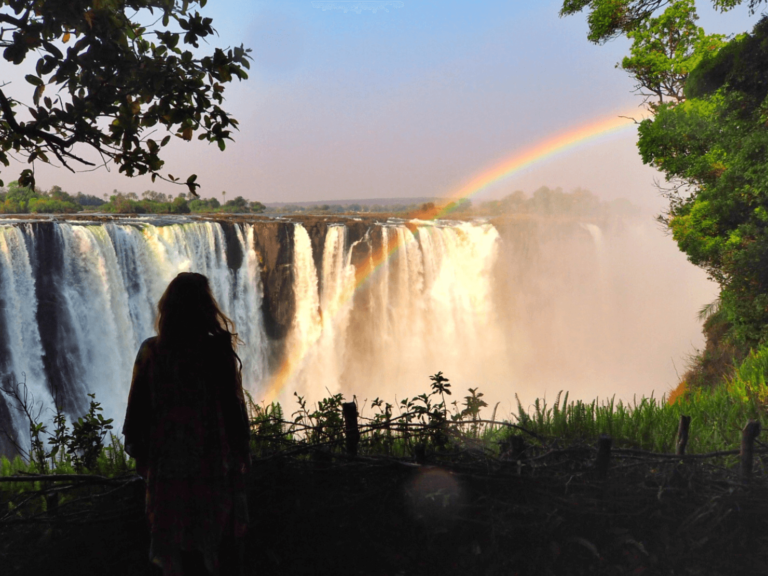
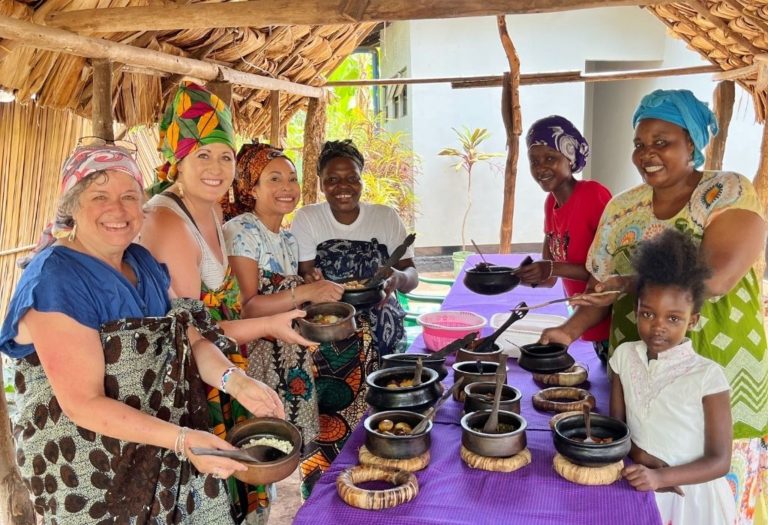
Chimanimani National Park is a great hiking destination. It sits on the border of Zimbabwe and Mozambique and while there you can climb Mt Binga which is Zimbabwe’s second highest mountain and Mozambique’s highest. The scenery is stunning and you can easily spend a few days hiking, camping in caves and testing your metal heading down head man’s pass.
Check out Colin who was our guide from the area for more info. It was one of the best few days we had in Zimbabwe for sure.
http://www.chimanimanitourguide.com
Nice post! Thanks for sharing!
Incredible list Helen! – awesome photos too!
Thanks!!! 🙂
Wow, where do you even start? Every place looks brilliant. I’ll would like to hike it all!
Incredible adventure for hikes. view of the mountain looking beautiful.
Thanks for sharing the article
We climbed Oldoinyo Lengai this July during our honeymoon. We’re from Colorado so hiking mountains is what we love to do! Lengai is very steep and will take you about 6 hours to summit. However, it is well worth the hike and the midnight start time! Do your homework beforehand and make sure you come prepared with a headlamp, jacket, gloves (highly recommend for the climb), and some comfy hiking boots. The hike down is honestly the hard part and takes the same amount of time as the hike up. You’ll get back to your car around noon. Very happy we did this hike. It was something different than just going to Africa for the animals. Honestly the best part of our trip!
Hi Helen,
Any suggestions on shorter hiking routes (ie. 1-2 day hikes) that are easily accessible from a major international airport in central or eastern, or southern Africa? I wanted to add a ~4day stop on my frequent trip down to South Africa, so I’m really open to any African destination as a stop… but the best hikes always seem to be really far from airports.
This list is top notch, thank you so much! 🙂
Never been to this beautiful continent, but would just love to explore it in this way and really get to know Africa’s, as you say, great outdoors. Seems challenging and satisfying at the same time.
Safe travels!
The physical benefits of trekking are numerous. Even just having something to train towards and aim for keeps people more accountable and disciplined with their training.
Hey Helen,
That’s an epic post.
Africa is one the most exotic and wild destinations that I’d like to experience.
Kilimanjaro is definitely on top of my “to visit list”.
Bloomin’ great article Helen! 😀 Me and my husband just recently got back from Africa, and we personally loved the 3/4 day hike to Geech/Cheneck camp, we covered so much distance and we were so knackered at the end of it, but the scenery was just breathtaking. Thank you so much for this article.
Hey Helen,
Reading your article was as almost exciting as actually experiencing those splendid Africa hikes.
The photos are gorgeous.
Can i recommend adding on Mt Meru in Tanzania, nr Kili, The Rwenzoris in Uganda, Mt Bisoke in Rwanda and Mt Cameroon. All great climbs
Malawi for me will always be the best location. I spent most of my youth around that area before moving to Western Europe. It has a certain “innate beauty” that i’ll never forget.
Mount Kenya needs to be on this list! Better than Kilimanjaro 😉